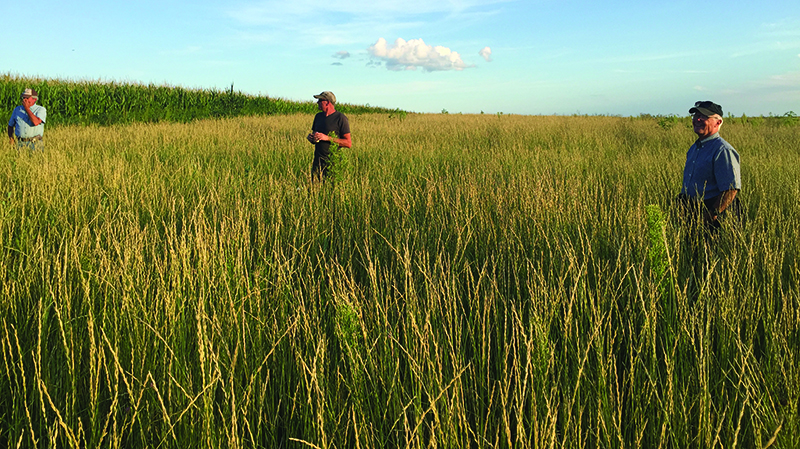KERNZA: Perennial Grain Now Available
COLIN CURETON, SUPPLY CHAIN DEVELOPMENT SPECIALIST
FOREVER GREEN INITIATIVE, UNIVERSITY OF MINNESOTA
Kernza® is a perennial grain crop that is winterhardy in the Upper Midwest. Albert Lea Seed is proud to be among the first companies to offer a commercially viable Kernza seed to our customers. Kernza has been in development for years, but this may be the first time you’ve heard of it. That’s why we asked Colin Cureton, PhD and the UMN Forever Green Kernza Team to give us an introduction.
WHAT IS KERNZA?
Kernza is the trademarked name for perennial grain products made from improved lines of intermediate wheatgrass, a Eurasian forage grass brought to the US in the early twentieth century. Kernza has been developed over the last several decades by the Rodale Institute, The Land Institute, and the University of Minnesota’s (UMN) Forever Green Initiative. UMN’s first Kernza variety, MN-Clearwater, was developed at the UMN in 2011. It shows greater yield, higher free-threshing, reduced shattering, and reduced lodging compared to other Kernza seed currently available.
HOW IS KERNZA DIFFERENT THAN OTHER GRAINS?
The most important difference is that Kernza is a perennial grain seed. Most other grain crops are annuals, leaving the soil bare for much of the year causing erosion, excess nutrient runoff, and higher greenhouse gas emissions. Kernza can address these issues while producing grain and forage harvests for multiple years. Kernza can produce profitable grain for 2-3 years in the Upper Midwest, and it can be managed as forage much longer. Kernza grain is smaller compared to many annual small grains, and it has a unique flavor profile and is high in protein.
WHAT ARE THE BENEFITS OF KERNZA (VERSUS OTHER GRAINS)?
Kernza production requires less nitrogen than most annual small grains and, because it’s a perennial wheat, the seed and other establishment costs are lower. Kernza has multiple environmental benefits. With its deep, dense root system—which can reach depths of more than 10 feet—Kernza can improve water quality and soil health, reduce erosion, and potentially sequester carbon. It can reduce nitrate leaching by more than 95 percent compared to annual row crops. The State of Minnesota’s Clean Water Legacy Fund is supporting ecosystem service payments and other support for early Kernza growers in targeted areas where groundwater is impaired or vulnerable to nitrate leaching.
PRODUCTION BASICS OF KERNZA
Kernza is very winter hardy, similar to winter rye, and can be grown in the Upper Midwest, Central Plains, Mountain West, the Northeast, and Canada. It performs well on various soil types. Kernza is planted in late summer and grain is harvested in late July/ early August, requiring vernalization to produce a grain crop. Seeding depth for Kernza is shallower than most annual small grains. The crop produces a lot more straw than annual small grains, which should be chopped or removed after grain harvest. Kernza performs better under relatively dry conditions compared to wet conditions. Kernza is not suitable for saturated buffer areas or soils that are prone to periodic flooding.
HOW DO I BECOME A KERNZA GROWER?
Kernza growers must be licensed before buying, planting, or marketing Kernza, and they must adhere to the trademark program and its associated Identity Preserved Program for the duration of their license. The Land Institute (TLI) owns and manages the Kernza trademark. The UMN Forever Green Initiative works closely with TLI to vet and license growers in the Upper Midwest. The trademark program includes guidelines for approved seed sources, production practices, and quality control. This ensures a perennial grain crop in the market that meets buyers’ and consumers’ quality and sustainability expectations. To apply to be a Kernza grower visit kernza.org. Growers must apply and be licensed by TLI before buying Kernza seed from Albert Lea Seed or other suppliers.
ARE THERE MARKETS FOR KERNZA?
Kernza is still in an early stage of market development. A producer cooperative, Perennial Promise Growers Cooperative, is forming to support grower success, provide high-quality, reliable grain to the market, and to provide grower leadership as Kernza develops. A new supply chain business, Perennial Foods, is bringing Kernza grain and flour direct to consumers and wholesale buyers across the US. Food companies and processors already have developed products that incorporate Kernza as at least one of the ingredients, including whole grain, flour, crackers, pasta, baked goods, spirits, and beer. Interested growers should reach out to other growers and early market partners to proactively plan for marketing your crop.
WHERE CAN I LEARN MORE ABOUT KERNZA?
For the latest news and other resources including the 2021 Kernza Grower Application, a Kernza production guide, and more, visit kernza.org. Growers interested to talk with other growers about production and marketing can contact Carmen Fernholz, Interim President of Perennial Promise Growers Cooperative at 320-212-3008 or fernholz001@gmail.com. Other questions about Kernza in MN and the Upper Midwest can be directed to Colin Cureton, Supply Chain Development Specialist for the UMN Forever Green Initiative at 612-750-5967 or cure0012@umn.edu, or Tessa Peters, Director of Crop Stewardship at The Land Institute at 970-412-9489 or peters@landinstitute.org
